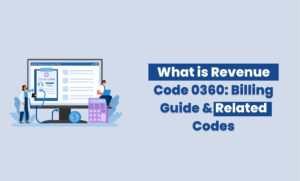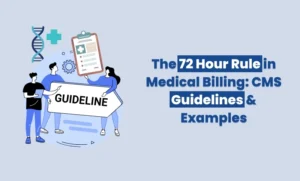Chest pain is one of the most frequent—and clinically sensitive—presenting complaints in healthcare. While cardiac causes often take priority in evaluation, musculoskeletal conditions like costochondritis are common non-cardiac sources of discomfort that can easily be misclassified or miscoded.
For providers, accurate diagnosis and precise coding are critical—not only for guiding appropriate care but also for ensuring smooth claim submission and reimbursement. The proper application of Costochondritis ICD 10 codes plays a central role in this process.
From identifying related symptoms to applying the correct ICD-10 code and avoiding common errors, this resource will help you stay compliant, reduce denials, and streamline revenue cycle efficiency.
What is Costochondritis?
Costochondritis is an inflammation of the cartilage that connects a rib to the sternum (breastbone), often resulting in localized chest wall pain. It is a musculoskeletal condition and, although benign, it can mimic life-threatening issues such as myocardial infarction or pulmonary embolism—making accurate clinical differentiation critical.
This condition is frequently seen in both primary care and emergency settings. It can be caused by trauma, overuse (especially in athletes), recent upper respiratory infections, or sometimes has no identifiable cause. The pain is typically sharp, localized, and reproducible on palpation over the affected costosternal junctions.
ICD-10 Code for Costochondritis
In the ICD-10-CM coding system, costochondritis is most accurately captured using:
Primary Code:
M94.0 – Chondrosternal syndrome
This code includes both costochondritis and Tietze’s syndrome, although the latter typically presents with visible swelling over the costosternal joint, while costochondritis does not.
Key Considerations:
- Laterality: ICD-10 does not require laterality (left/right) for M94.0, but including it in clinical documentation is considered best practice.
- Specificity: Providers should ensure that documentation clearly supports an inflammatory etiology rather than generalized or unexplained chest pain.
- Billable Code: M94.0 is a billable code, making it suitable for use on claims as a primary diagnosis when the condition is confirmed.
Related ICD-10 Codes
Sometimes, a patient’s presentation may not fully align with classic costochondritis. In such cases, related codes can help capture the full clinical picture:
| Code | Description | When to Use |
| M94.8 | Other specified cartilage disorders | When clinical findings suggest cartilage pathology but not typical of M94.0 |
| M94.9 | Disorder of cartilage, unspecified | Use only when documentation is incomplete or unclear |
| R07.9 | Chest pain, unspecified | Use if costochondritis is only suspected, not confirmed |
| R07.82 | Intercostal pain | For rib pain without inflammation or when costochondritis is ruled out |
| M54.6 | Pain in thoracic spine | Use if thoracic spine issues mimic costochondritis symptoms |
Exclusion Notes:
If cardiac or pulmonary causes are identified, avoid using M94.0. Common exclusion codes include:
- I20.9 – Angina pectoris, unspecified
- J18.9 – Pneumonia, unspecified organism
Proper code selection reflects both clinical accuracy and helps reduce claim denials or audits due to misrepresentation of the patient’s true condition.
Common Symptoms and Diagnosis Tips
Recognizing costochondritis begins with understanding its hallmark features. Accurate symptom identification aids not only in clinical diagnosis but also supports proper documentation for ICD-10 coding.
Typical Clinical Presentation:
- Sharp, stabbing, or aching chest pain
- Pain localized to one or more costosternal joints
- Reproducible tenderness on palpation
- Pain worsens with deep breathing, coughing, or movement
- Absence of cardiac or pulmonary symptoms (normal EKG, chest X-ray)
Diagnosis Tips for Providers:
- Rule out cardiac causes—especially in patients over 40 or with cardiovascular risk factors.
- Document findings from the physical exam that confirm localized tenderness.
- Include response to anti-inflammatory treatment if applicable.
- Note any recent physical activity, trauma, or upper respiratory infections as potential contributors.
Accurate diagnosis combined with well-supported documentation ensures proper use of Costochondritis ICD 10 codes and reduces unnecessary testing or payer scrutiny.
Clinical Documentation Requirements
Accurate and thorough documentation is the foundation of compliant coding and successful reimbursement. For Costochondritis ICD 10 (M94.0), providers must ensure that the clinical notes clearly support the diagnosis.
Key Elements to Document:
- Location of pain: Typically anterior chest wall, costosternal junctions
- Provocative findings: Pain reproduced by palpation or movement
- Onset and duration: Acute vs. chronic, sudden or gradual
- Associated symptoms: Absence of shortness of breath, fever, or cardiac signs
- Diagnostic exclusions: Negative cardiac workup (e.g., EKG, troponin) or imaging to rule out pulmonary causes
- Treatment plan: Use of NSAIDs, heat therapy, or physical therapy recommendations
Billing Guidelines for Costochondritis
Proper billing begins with selecting the right diagnosis code but extends to supporting services, modifier use, and medical necessity.
Key Billing Components:
Diagnosis Code: M94.0 (Chondrosternal syndrome)
Common CPT Codes Used:
- 99213–99215 for office visits (based on complexity)
- Diagnostic tests (e.g., 93000 for EKG, 71046 for chest X-ray) if medically necessary
Modifiers:
- Modifier 25: Append when a separately identifiable E/M service is performed in addition to another procedure (e.g., X-ray, injection)
- Modifier 59: If multiple procedures are performed that are not typically reported together
Place of Service (POS):
- 11: Office
- 22: Outpatient hospital setting
Medical Necessity and Payer Documentation:
To prevent denials, ensure:
- Clinical findings support diagnosis
- Exclusion of cardiac/pulmonary causes is clearly documented
- All billed services (like imaging) are justified based on symptoms and exam
Reimbursement and Payer Considerations
Coverage:
Most private payers and Medicare recognize M94.0 as a reimbursable diagnosis when supported by clinical documentation.
Common Issues with Reimbursement:
- Denials due to inadequate documentation (especially if cardiac evaluation is missing)
- Claim rejections when symptom codes (like R07.9) are used alone without confirmation of diagnosis
- Reduced payments if E/M levels are not justified by documentation
Best Practices:
- Submit all relevant codes: e.g., M94.0 for diagnosis + R07.9 for presenting symptom (if still unresolved)
- Review payer-specific policies; some may require documentation of failed conservative treatment before approving advanced imaging
Include detailed exam findings and decision-making rationale in each note. This helps justify not just the diagnosis code but the level of E/M billed.
Common Coding Errors to Avoid
Coding errors not only delay reimbursement but may also trigger audits. Here are the most frequent mistakes seen with Costochondritis ICD 10 coding:
| Error | Correction |
| Using R07.9 (unspecified chest pain) as the primary code after diagnosis is confirmed | Use M94.0 once costochondritis is established |
| Inadequate documentation of differential diagnosis | Clearly document that cardiac and pulmonary causes have been ruled out |
| Using M94.9 without reason | Only use when the presentation is vague or documentation is incomplete |
| Missing modifier 25 on same-day procedures | Append modifier when appropriate to avoid bundling denials |
Bottom Lines
Navigating chest pain complaints can be complex, but when costochondritis is identified, clear documentation and precise ICD-10 coding make all the difference—for both clinical and financial outcomes.Using Costochondritis ICD 10 code M94.0 appropriately ensures accurate diagnosis reporting, reduces claim denials, and supports proper reimbursement. By following the guidelines in this article—covering everything from coding to payer expectations—you’ll improve coding accuracy, streamline billing workflows, and better serve your patients.





